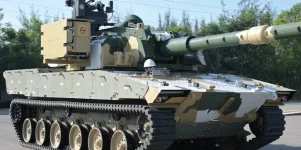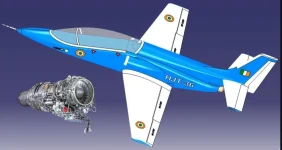- Views: 1K
- Replies: 5
The development of India’s indigenous aerial combat capabilities is poised for a significant leap as the Electronics & Radar Development Establishment (LRDE) gears up to commence critical testing of the Uttam Mk2 Active Electronically Scanned Array (AESA) radar.
This advanced sensor system will serve as the primary eyes for the highly anticipated Tejas Mk2 fighter aircraft, which is on schedule to initiate flight testing in 2027.
According to emerging reports, the Uttam Mk2 has formally entered its ground-testing phase. This development represents a crucial junction in the nation's strategic roadmap to equip its air combat fleet with state-of-the-art, domestically produced radar technology.
Strategic Shift to Gallium Nitride (GaN) Technology
Sources close to the programme have revealed that the Uttam Mk2 will be equipped with approximately 980 Transmit/Receive Modules (TRMs) utilising Gallium Nitride (GaN) technology.This configuration mirrors the enhanced specifications finalised for the Indian Air Force’s (IAF) recent acquisition of 97 Tejas Mk1A aircraft. This synchronisation indicates a deliberate strategic pivot by the Defence Research and Development Organisation (DRDO) and the IAF.
While earlier iterations of the radar successfully cleared flight trials using roughly 912 Gallium Arsenide (GaAs) modules, stakeholders have chosen to standardise the fleet on the more potent GaN architecture.
This newer technology offers distinct advantages, including superior detection ranges, enhanced resistance to enemy jamming, and greater operational flexibility.
"The earlier version with fewer TRMs served as an excellent proof of concept, but the 980-module GaN array provides the decisive advantage required for modern, contested airspace," a senior LRDE official stated.
"Fortunately, the backend electronics, signal processing algorithms, and core processors remain largely consistent with the previous version. We are upgrading only the front-end modules and the antenna array, which saves us from restarting the entire testing cycle. Current ground trials are strictly focused on validating high-power output and thermal management systems."
Standardisation Across the Fleet
The move towards GaN technology was further accelerated by the Cabinet Committee on Security’s (CCS) 2025 approval for 97 additional Tejas Mk1A jets, a deal valued at ₹48,000 crore. This order brings the total Mk1A fleet to 180 aircraft.While the initial batch of 83 jets will be inducted with the Israeli EL/M-2052 AESA radar to ensure rapid deployment, the subsequent 97 aircraft—expected to begin deliveries around 2027–28—will feature the indigenous Uttam radar with the 980 GaN TRM setup.
Confirmed by HAL Chairman DK Sunil, this upgrade is expected to extend the detection range for fighter-sized targets (2 m² RCS) to between 200 and 250 kilometres.
Furthermore, the system will be capable of tracking 64 targets simultaneously and engaging up to six at once using active radar-homing missiles such as the Astra Mk2.
Innovative Swashplate Design for the Tejas Mk2
For the Tejas Mk2, a larger and more potent 4.5-generation fighter, the Uttam Mk2 will be the baseline sensor from the Limited Series Production (LSP) stage onwards.A key feature of this variant is its "swashplate-enabled" design. This mechanical innovation allows the radar antenna to be physically repositioned, providing a field-of-view exceeding 100 degrees and a search volume of up to 140 degrees.
This capability is tactically significant as it eliminates the need for pilots to execute aggressive manoeuvres to maintain a radar lock during dogfights.
The GaN modules, capable of an output between 10–15 watts each, offer 40–50% better efficiency and heat dissipation compared to older GaAs technology. This ensures the radar can sustain high-power operations even in India's demanding "hot-and-high" climatic conditions.
Timeline and Future Implications
Engineers at LRDE’s Bengaluru facility are currently validating the beam-forming accuracy of the new antenna array and the reliability of the GaN modules under simulated combat conditions."Because we are utilising a shared backend architecture, we are building upon already validated flight data rather than starting from scratch," the official noted.
Following the ground trials, captive flight trials aboard a modified Tejas or Hawk testbed are scheduled for late 2026. These tests will pave the way for the Tejas Mk2 prototype (PV-1) to make its maiden flight in the first quarter of 2027.
The convergence of the Mk1A and Mk2 radar programmes highlights the DRDO’s modular design philosophy.
The core 980-TRM GaN technology is designed to be scalable, serving as the foundation for larger variants destined for the Su-30MKI upgrades (featuring 2,400+ TRMs) and the future Advanced Medium Combat Aircraft (AMCA, featuring 1,400+ TRMs).
With an indigenous content ratio of 90%, the Uttam radar is projected to reduce costs by 30–40% compared to imported alternatives like the EL/M-2052, strongly aligning with the government's Atmanirbhar Bharat initiative.





